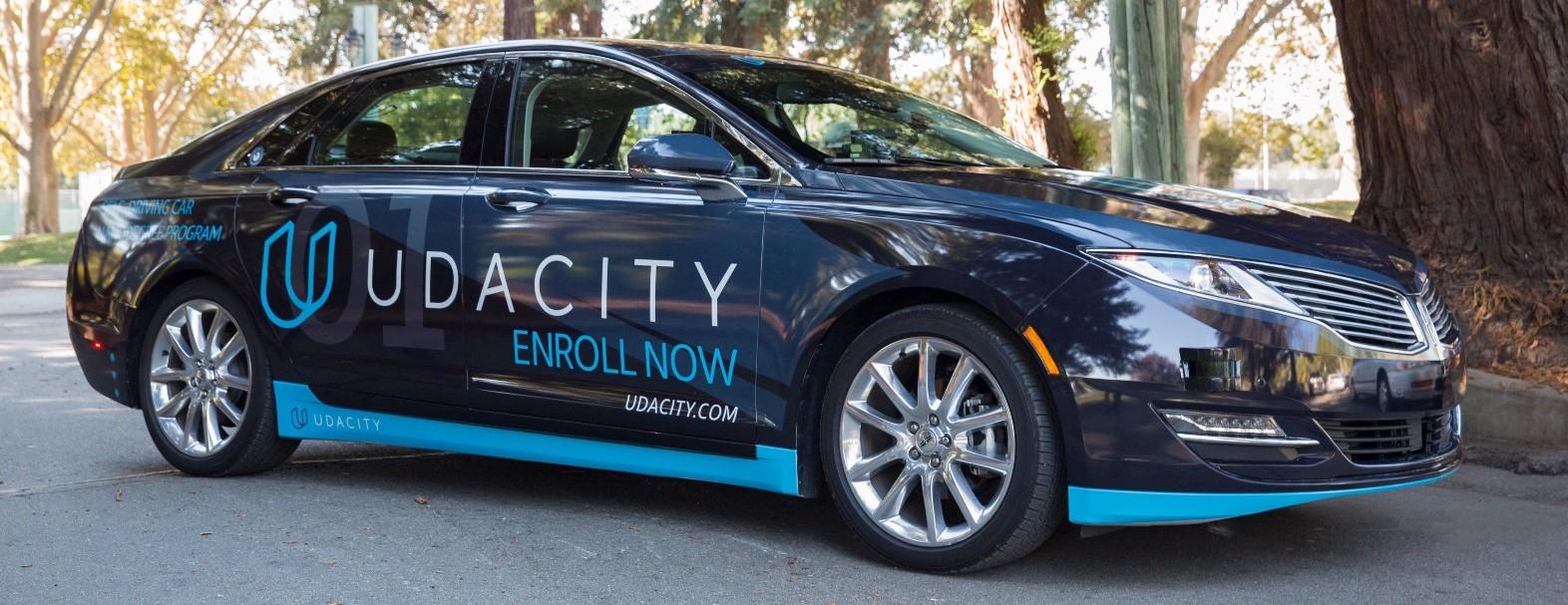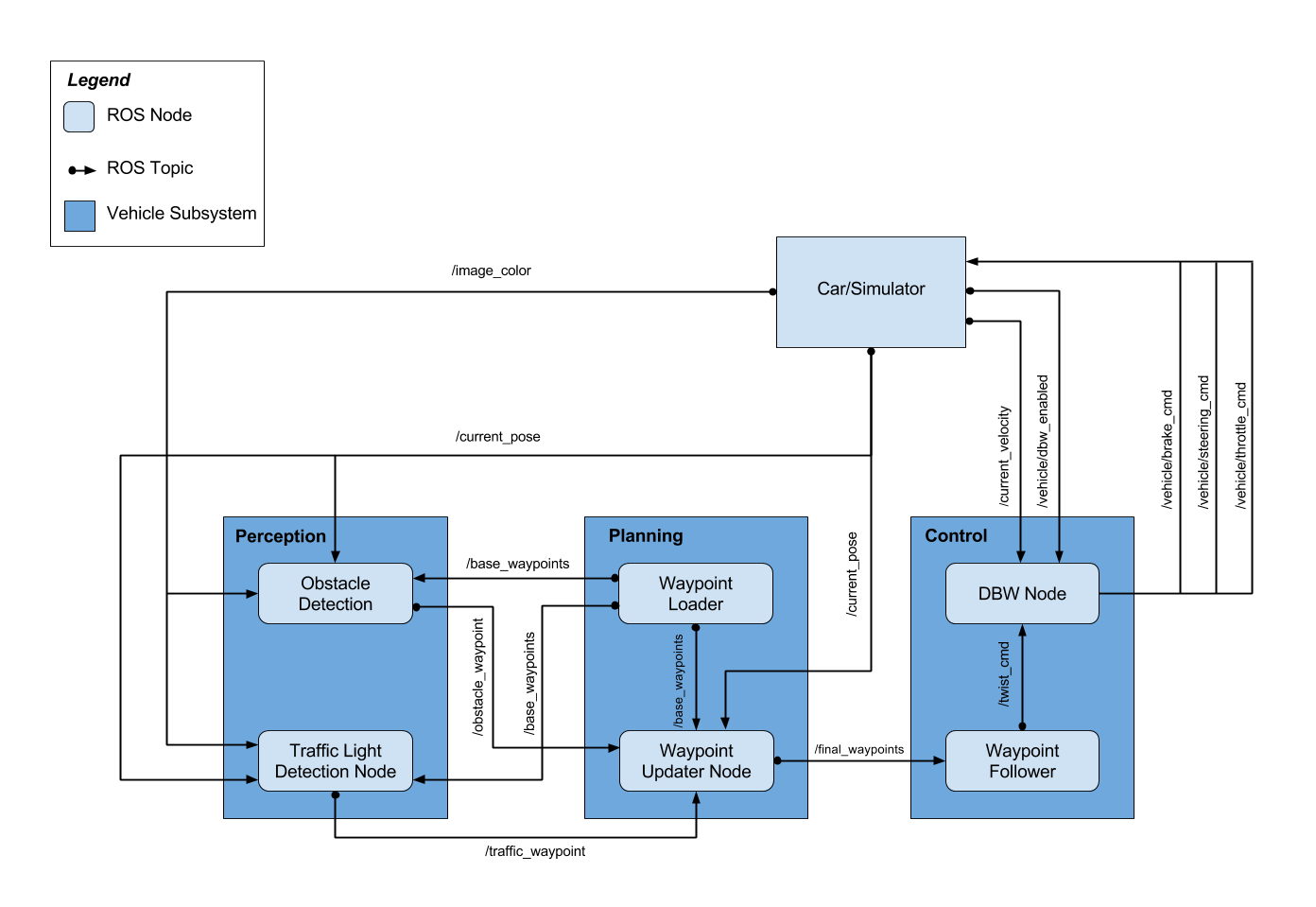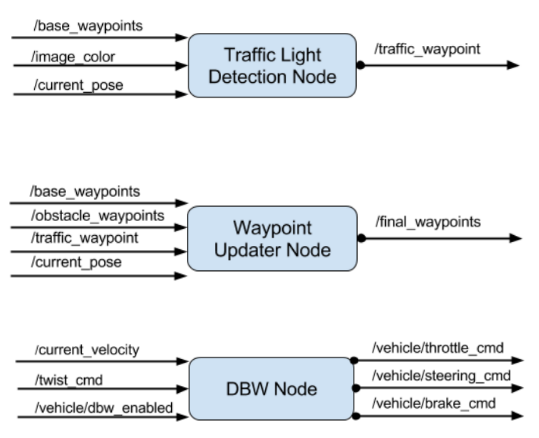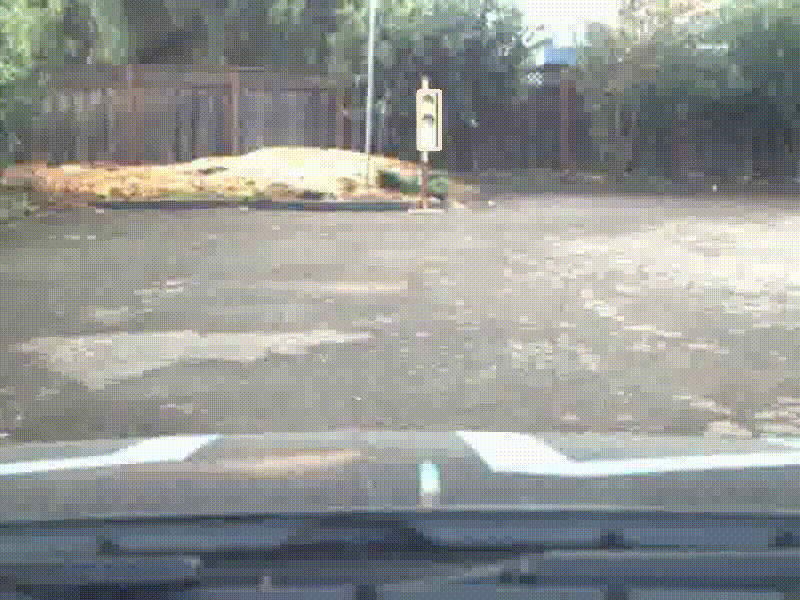In this project, we built ROS nodes to implement the core functionality of the autonomous vehicle system, including traffic light detection and classification, vehicle control control, and waypoint following. This software system will be deployed on Carla (Udacity’s Self Driving Lincoln MKZ) to autonomously drive it around a test track.
- Maciej Dziubinski (ponadto@gmail.com)
- Ankit Shrivastava (shrivastavaanki700@gmail.com)
- Mohamed Ameen (mohamed.a.ameen93@gmail.com)
The following graph presents the ROS nodes and ROS topics comprising the system:
We were responsible for three nodes in particular:
- the
'tl_detector'node (implemented in thetl_detectorpackage) that publishes to the/traffic_waypointtopic the location to stop before a red light. - the
'waypoint_updater'node (implement in thewaypoint_updaterpackage) that publishes a list of waypoints (which determine the velocity) ahead of the car to the/final_waypointstopic. - the
'dbw_node'(in thetwist_controllerpackage) that publishes to three topics:vehicle/throttle_cmd,/vehicle/brake_cmd, and/vehicle/steering_cmdwhich control the car.
A good summary of those three nodes is presented below:
Note: For this project, the obstacle detection node is not implemented
The following excerpt from the tree command summarizes the structure of the
ros/src directory (actually, the nodes that were presented in the
Project structure section above):
./ros/src
...
│
├── tl_detector
│ ├── light_classification
│ │ └── tl_classifier.py
│ ├── light_publisher.py
│ └── tl_detector.py
│
├── twist_controller
│ ├── dbw_node.py
│ ├── dbw_test.py
│ ├── lowpass.py
│ ├── pid.py
│ ├── twist_controller.py
│ └── yaw_controller.py
│
└── waypoint_updater
└── waypoint_updater.py
This subsystem is responsible for detecting and inferring the environment surrounding the vehicle, and publishing relevant information to other subsystems. Specifically, this subsystem determines the state of the upcoming traffic lights and publishes this status to other subsystems.
This node processes images provided by the vehicle’s onboard camera and publishes upcoming traffic light information to the /traffic_waypoint topic. The Waypoint Updater node uses this information to determine if/when the car should slow down to safely stop at upcoming red lights.
We initially trained a basic neural network to do the classification task. The network architecture is shown below:
For training images, a combination of web scraping, simulator image capturing, and ROSbag image capturing was used. We used Keras (with Tensorflow as backend) for training with a total of 2,000 images (10% of which as validation/test samples).
*Note: This model, and the included data, is based on this project on GitHub.
Although the model's results were acceptable, we decided to use an SSD model to simultaneousely detect and classifiy the traffic lights, instead for building twi separate models, one for detection, and another one for classification.
This approach means basically using a pre-trained model to detect and classify the traffic lights.
After experimenting with different models, including SSD, FRCNN, and RFCN, we found out that an FRCNN model pre-trained on COCO dataset would perform very well, but the problem is it was very slow, we needed something really fast!
SSD model was extremely faster that FRCNN, but its performance was poor. So finally, we decided to use an SSD model pre-trained on COCO dataset, and then retrained on Apollo Traffic Lights Detection Dataset.
We extraxted the site data from the rosbag provided by Udacity and applied the model, and it was very accurate on detecting and classifying the traffic lights.
The planning subsystem determines the vehicle’s path based on the current position and velocity along with the state of the traffic lights. A list of waypoints to follow is passed on to the control subsystem.
The eventual purpose of this node is to publish a fixed number of waypoints ahead of the vehicle with the correct target velocities, depending on traffic lights and obstacles. This node subscribes to three topics to get the entire list of waypoints, the vehicle’s current position, and the state of the traffic lights. Then the node publishes a list of waypoints to follow, each waypoint contains a position on the map and a target velocity.
This subsystem publishes control commands for the vehicle’s steering, throttle, and brakes based on a list of waypoints to follow.
This node is implemented by Udacity. It parses the list of waypoints to follow and publishes proposed linear and angular velocities to the /twist_cmd topic.
The goal for this part of the project is to implement the drive-by-wire node which will subscribe to /twist_cmd and use various controllers to provide appropriate throttle, brake, and steering commands. These commands can then be published to the following topics:
/vehicle/throttle_cmd/vehicle/brake_cmd/vehicle/steering_cmd
- Clone the project repository.
git clone https://github.com/MTDzi/CarND-Capstone-
Install python dependencies.
-
Make and run styx.
cd ros
catkin_make
source devel/setup.sh
roslaunch launch/styx.launch- Run the simulator.
- Download training bag that was recorded on the Udacity self-driving car.
- Unzip the file.
unzip traffic_light_bag_file.zip- Play the bag file.
rosbag play -l traffic_light_bag_file/traffic_light_training.bag- Launch your project in site mode.
cd CarND-Capstone/ros
roslaunch launch/site.launch- Confirm that traffic light detection works on real life images.




